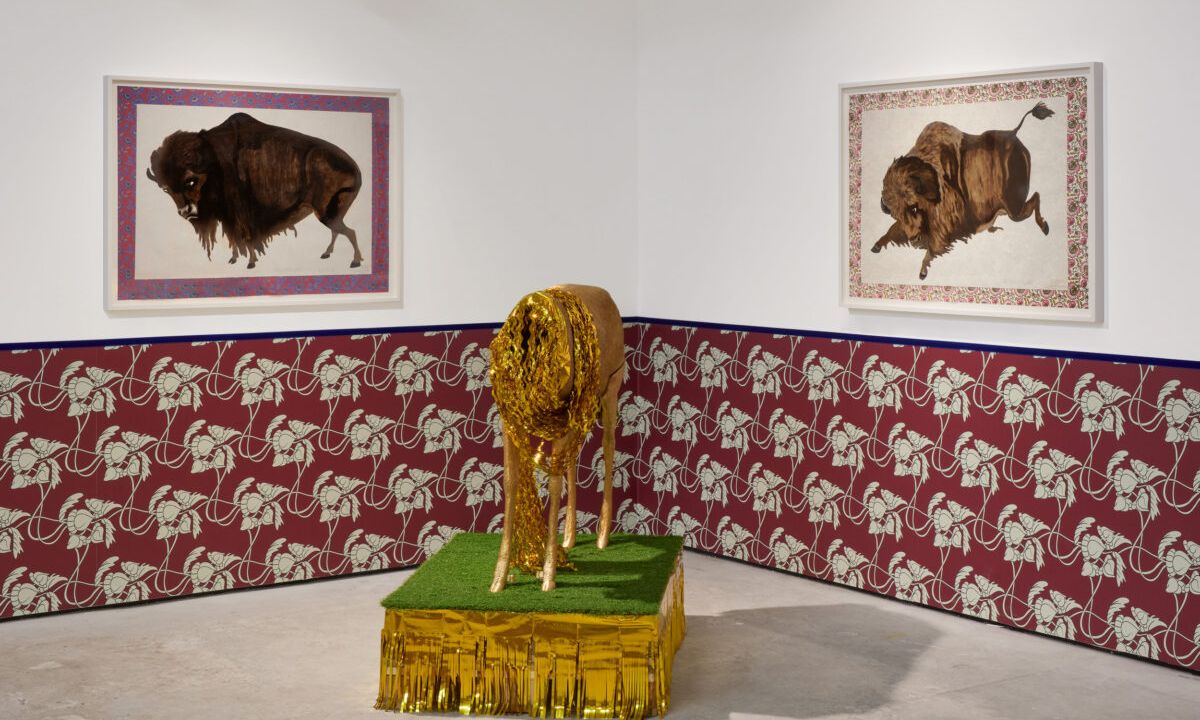Wendy Red Star’s installation In the Shadow of the Paper Mountains (2024) employs a greetings card aesthetic to re-create the landscape of Montana’s Apsáalooke (Crow) Reservation
Courtesy Gathering, London
Since early June, walking into the London gallery Gathering has meant entering a colourful, 3D panorama of mountaintops, forest glades and a winding river reminiscent of a stage set for a primary school play. But the installation is not a vacuous vision of pastoral escape; it is a new work by the Apsáalooke (Crow) artist Wendy Red Star that ruminates on the colonisation of Native American land.
Her exhibition, In the Shadow of the Paper Mountains (until 14 September), takes its name from this new sculptural work. Made of painted fibreboard, the installation “intends to capture the reductive design language of the cheap greeting card and apply it to the Montana Crow Reservation landscape”, a press statement reads. The artist has added an audio recording from the Pryor Mountains—a sacred site of Apsáalooke history and folklore—that layers birdsong atop the sounds of insects and running water. These elements combine to raise a niggling question: How much of the complex truth of this place and its culture are being flattened in these generic images?
Red Star, whose practice also incorporates painting, photography, textiles and performance, continues this inquiry downstairs at Gathering. There, she is exhibiting the installation Tokens, Gold, & Glory (2016), in which headless hunting decoys of deer wrapped in gold Mylar stand on pallets covered in artificial turf, alongside a series of new buffalo paintings. Each piece foregrounds the falseness of the tropes used by others for centuries to caricature and commodify Indigenous American cultures.
The critique is as urgent today as ever. As Red Star said in a recent Financial Times interview, “Native artists are hot right now”. While a reckoning on Indigenous rights has helped bring Native artists to new prominence in North American cultural institutions over the past decade, an accompanying commercial surge has led gallerists, auction houses and advisers to champion them with new vigour internationally. Already, 2024 has included high-profile examples on each side; the Venice Biennale opened with a record number of Indigenous artists from all over the world, followed by an increased presence of works by such artists on offer at Art Basel’s flagship fair in June. Dealers at the latter talked openly about the growing waiting lists and sharp price rises some of these works have generated within the past two years.
Daasáwatash/One Heart, 2024
The New York-based adviser Wendy Cromwell cautions that prices for contemporary Indigenous artists of the Americas “are not necessarily being raised across the board”, saying that such leaps are “specific to the artist’s career”. At the same time, she acknowledges the momentum behind certain artists in this broad demographic. “With increasing commercial exposure, the beginnings of a market have formed,” she says. “If the work continues to be shown internationally at art fairs and in biennials, then prices will rise.”
Red Star is riding this wave. She has exhibited widely across the US in recent years, including solo shows at the Massachusetts Museum of Contemporary Art and the Anderson Collection at Stanford University, as well as group shows at the Metropolitan Museum of Art in New York, the Museum of Contemporary Art Chicago and Washington, DC’s National Mall, to name a few. Her show at Gathering is her first in a commercial gallery in Europe, proving that the cultural specificity of her practice travels.
“It was important for me to consider how my pieces, which often explore Native American identity and history, would resonate with a European context,” Red Star tells The Art Newspaper. “These pieces incorporate elements that reflect both my heritage and a sense of universality that I believe can connect with viewers across different cultures.”
The artist, who attended the opening of the show at Gathering, has been heartened by its reception. “Visitors have expressed a strong interest in the themes of identity, colonialism and resilience that run through my work,” she says. “Many have shared how these themes resonate with current discussions in Europe about history and representation.”
Alex Flick, Gathering’s founding director, also believes in the broad appeal of Red Star’s practice. “Great art transcends nationalities,” he says. “Paul McCarthy’s work looks in hyper detail at the American psyche, while Gerhard Richter’s early paintings were concerned with post-war Germany. A more pertinent and recent example is Jeffrey Gibson’s American Pavilion at this year’s Venice Biennale. With all these artists, beyond the first reading and obvious references, there are universal themes at play that cut through national interests.”
Prices for the works at Gathering range from £8,000 to £40,000. Flick said in early August that some of Red Star’s works had already sold and that the gallery was in talks with some leading UK institutions: “To launch an artist with an at times challenging, multidisciplinary practice into a new market is not always easy. But I’ll say I’m very happy with how the show has gone, given it was Wendy’s first foray into the European market.”
Red Star is currently represented by the New York- and Los Angeles-based gallery Sargent’s Daughters. When asked if she would be joining Gathering’s roster, Flick responded: “It would be an honour.” He says that he has been following Red Star’s work since 2020 after seeing her Four Seasons (2006) series, in which she photographed herself dressed in traditional Apsáalooke regalia against fake nature backdrops, mocking romantic idealisations of Native Americans in popular culture.
“Wendy is one of the most engaged contemporary voices working in America,” Flick says. “Her pertinent work deserves a broad international audience.”

